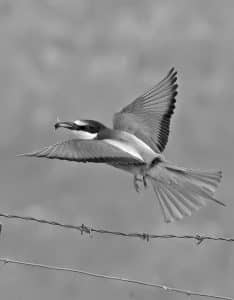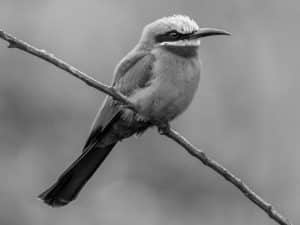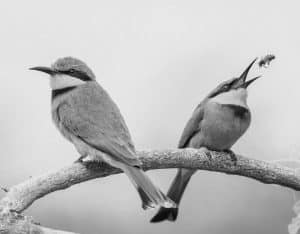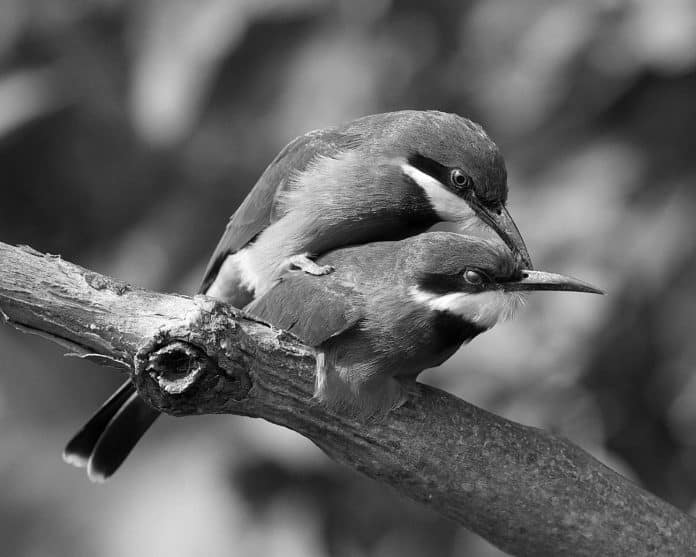Introduction to Bee-Eaters
Welcome to the vibrant world of bee-eaters in Tanzania! These stunning birds are a sight to behold with their dazzling plumage and remarkable aerial acrobatics. The bee-eaters, belonging to the Meropidae family, are known for their distinctive hunting techniques and vibrant colors, making them a popular subject for birdwatchers and wildlife enthusiasts. Tanzania, with its diverse habitats and rich biodiversity, provides an ideal setting for observing these magnificent creatures in their natural environment.

The bee-eaters are a group of near-passerine birds found in various regions across the world, including Africa, Asia, and Europe. In Tanzania, these avian gems can be spotted in a range of habitats, from woodlands and savannas to riverbanks and grasslands. Their striking appearance and captivating behaviors make them a fascinating species to study and admire. Throughout this article, we will delve into the captivating world of bee-eaters in Tanzania, exploring their habitat, behavior, breeding habits, and the vital role they play in the country’s ecosystem.
The Habitat and Behavior of Bee-Eaters in Tanzania
Tanzania, renowned for its diverse landscapes and wildlife, is home to several species of bee-eaters, each adapted to specific habitats within the country. These captivating birds are often found in open areas with access to suitable nesting sites and an abundant supply of their primary food source – flying insects. The undulating flight patterns of bee-eaters as they dart and swoop in pursuit of their prey are a mesmerizing sight for onlookers.
One of the most striking behaviors of bee-eaters is their hunting technique, which involves perching on exposed branches or wires, then launching into the air to catch insects on the wing. Their keen eyesight and agile flight allow them to snatch bees, wasps, dragonflies, and other flying insects with remarkable precision. This distinctive hunting behavior, coupled with their vibrant plumage, makes bee-eaters a captivating subject for birdwatchers and photographers alike.
The Colorful Plumage of Tanzanian Bee-Eaters
One of the most enchanting features of bee-eaters is their vibrant and varied plumage. These birds exhibit a stunning array of colors, including shades of green, blue, red, and chestnut, often arranged in intricate patterns across their feathers. The iridescent hues of bee-eaters are particularly prominent during the breeding season when they engage in elaborate courtship displays, showcasing their dazzling colors to attract potential mates.
The vivid plumage of bee-eaters serves both practical and aesthetic purposes. Not only does it contribute to their visual allure, but it also plays a role in communication and species recognition. For instance, the bright colors and patterns of bee-eaters may signal their health and vitality to potential mates, while also serving as a form of camouflage in their natural surroundings. As we delve deeper into the world of bee-eaters, we will uncover the significance of their colorful plumage in the context of their breeding and nesting habits.
Breeding and Nesting Habits of Bee-Eaters
During the breeding season, bee-eaters engage in captivating displays of courtship and bonding rituals, often characterized by aerial chases, gift offerings, and vocalizations. These intricate behaviors culminate in the selection of nesting sites, where bee-eaters construct burrows in sandy banks or cliffs to rear their young. The excavation of nesting tunnels is a remarkable feat, as bee-eaters use their bills and feet to dig into the soil, creating intricate burrows that serve as safe havens for their offspring.
Once the nesting burrows are established, bee-eaters engage in cooperative breeding, with both parents taking on the responsibilities of incubating the eggs and caring for the hatchlings. This shared parental investment ensures the survival and well-being of the offspring, highlighting the complex social dynamics within bee-eater colonies. As the chicks grow and develop, they are fed a diet of regurgitated insects, providing essential nutrients for their growth and development. The breeding and nesting habits of bee-eaters offer a fascinating glimpse into their familial bonds and reproductive strategies, underscoring the importance of these birds in Tanzania’s avian ecosystem.
The Role of Bee-Eaters in Tanzania’s Ecosystem

Beyond their aesthetic appeal and captivating behaviors, bee-eaters play a crucial role in maintaining ecological balance within Tanzania’s diverse habitats. As consummate insect hunters, bee-eaters help regulate insect populations, including pest species that can have detrimental effects on agricultural crops and natural ecosystems. By preying on flying insects, bee-eaters contribute to the control of insect populations, thereby mitigating potential ecological imbalances and providing essential ecosystem services.
Furthermore, the nesting activities of bee-eaters, particularly their excavation of burrows, can have significant effects on local soil composition and nutrient cycling. The presence of nesting colonies contributes to the physical structure of the landscape, creating microhabitats that support a diverse array of flora and fauna. Through their foraging behaviors and nesting activities, bee-eaters contribute to the ecological dynamics of Tanzania’s ecosystems, underscoring their importance as key players in the intricate web of life.
Conservation Efforts for Bee-Eaters in Tanzania
As with many wildlife species, bee-eaters face various threats to their populations, including habitat loss, human disturbance, and climate change. Recognizing the importance of conserving these captivating birds, Tanzania has implemented various conservation initiatives aimed at safeguarding bee-eater habitats and raising awareness about their ecological significance. Protected areas and wildlife reserves in Tanzania serve as critical refuges for bee-eaters and other avian species, providing essential sanctuary for their survival.
In addition to protected areas, community-based conservation efforts and education programs play a pivotal role in promoting coexistence between local communities and bee-eaters. By engaging with stakeholders and fostering a deeper understanding of the ecological value of bee-eaters, conservation organizations and governmental agencies strive to ensure the long-term viability of these enchanting birds. Through collaborative efforts and sustainable practices, Tanzania is dedicated to preserving the spectacular beauty of bee-eaters for future generations to cherish and admire.
Tips for Birdwatching Bee-Eaters in Tanzania
If you’re eager to embark on a birdwatching adventure in Tanzania, here are some valuable tips for observing and appreciating the beauty of bee-eaters in their natural habitat:
- Seek out suitable habitats: Look for open areas near water bodies, grasslands, and woodlands where bee-eaters are known to frequent. Pay attention to their distinctive calls and flight patterns to locate their presence.
- Use binoculars and spotting scopes: Equipping yourself with quality optics will enhance your birdwatching experience, allowing you to observe bee-eaters’ behaviors and plumage details from a distance without causing disturbance.
- Respect their space: While observing bee-eaters, maintain a respectful distance and avoid disrupting their natural behaviors. Minimize noise and sudden movements to ensure minimal disturbance to the birds.
- Learn their vocalizations: Familiarize yourself with the unique calls and vocalizations of bee-eaters, as this can aid in locating their whereabouts and understanding their communication within the avian community.
- Capture the moment responsibly: If you’re a photography enthusiast, exercise ethical practices when photographing bee-eaters, prioritizing the welfare of the birds and their habitats while capturing their stunning beauty.
By following these tips and approaching birdwatching with a mindful and considerate approach, you can enrich your experience of observing bee-eaters in Tanzania while contributing to their conservation through responsible ecotourism practices.
Capturing the Beauty of Tanzanian Bee-Eaters Through Photography
For photography enthusiasts, bee-eaters present a captivating subject for capturing stunning images of these colorful avian wonders in their natural environment. Whether you’re an amateur photographer or a seasoned professional, the vibrant plumage, dynamic flight patterns, and expressive behaviors of bee-eaters offer a wealth of photographic opportunities. Here are some tips for photographing bee-eaters in Tanzania:
- Study their behavior: Observe the hunting, perching, and courtship behaviors of bee-eaters to anticipate moments of action and interaction that make for compelling photographic compositions.
- Utilize natural light: Take advantage of the soft, early morning or late afternoon light to enhance the colors and textures of bee-eaters’ plumage, avoiding harsh midday sun that can create harsh shadows.
- Focus on flight shots: Capture the agility and grace of bee-eaters in flight, experimenting with different shutter speeds to convey their dynamic aerial maneuvers with clarity and precision.
- Showcase their environment: Incorporate the surrounding habitat into your compositions to provide context and a sense of place, highlighting the interconnectedness of bee-eaters with their natural surroundings.
- Practice patience and respect: Allow the birds to acclimate to your presence and avoid disrupting their activities, prioritizing the welfare of the subjects and their habitats while capturing their visual splendor.
By approaching photography with an appreciation for the natural behaviors and habitats of bee-eaters, you can create compelling images that celebrate the beauty and significance of these remarkable birds in Tanzania’s wildlife.
Popular Locations for Viewing Bee-Eaters in Tanzania

Tanzania offers a wealth of prime locations for observing bee-eaters in their natural habitats, each providing unique opportunities for birdwatching and wildlife photography. Here are some popular locations where you can immerse yourself in the captivating world of Tanzanian bee-eaters:
- Selous Game Reserve: This expansive reserve, known for its diverse ecosystems and abundant wildlife, provides opportunities to spot bee-eaters along the waterways and open savannas, offering a rich tapestry of avian and terrestrial biodiversity.
- Tarangire National Park: Renowned for its iconic baobab trees and seasonal gatherings of wildlife, Tarangire National Park is a haven for bee-eaters, with the park’s diverse habitats serving as ideal hunting grounds for these colorful birds.
- Lake Manyara National Park: Nestled at the base of the Great Rift Valley, Lake Manyara National Park is a birdwatcher’s paradise, where the lush groundwater forest and alkaline lake attract a profusion of bird species, including various bee-eaters.
- Serengeti National Park: While famed for its awe-inspiring wildebeest migration, the Serengeti also hosts an array of birdlife, including bee-eaters that can be observed in different habitats across the expansive savanna plains.
- Ruaha National Park: As Tanzania’s largest national park, Ruaha offers a rugged and remote landscape where bee-eaters thrive amidst the diverse terrain, providing an immersive setting for birdwatching and ecological discovery.
Conclusion: Preserving the Spectacular Beauty of Tanzanian Bee-Eaters
In conclusion, the colorful beauty of bee-eaters in Tanzania epitomizes the enchanting diversity of the country’s avian inhabitants. From their vibrant plumage and captivating behaviors to their vital role in maintaining ecological balance, bee-eaters stand as emblematic symbols of Tanzania’s rich wildlife heritage. As we immerse ourselves in the visual journey of observing and appreciating these remarkable birds, it is imperative to recognize the importance of conservation efforts in preserving their habitats and ensuring their continued existence in the wild.
By fostering a deeper understanding of bee-eaters and their significance within Tanzania’s ecosystems, we can contribute to the sustainable stewardship of these avian treasures for generations to come. Through responsible ecotourism, community engagement, and conservation advocacy, we can uphold the splendor of Tanzanian bee-eaters and safeguard their place in the intricate tapestry of the country’s natural heritage. Let us embark on a collective endeavor to preserve the colorful beauty of bee-eaters in Tanzania, ensuring that their vibrant presence continues to grace the skies and landscapes of this remarkable East African nation.

































